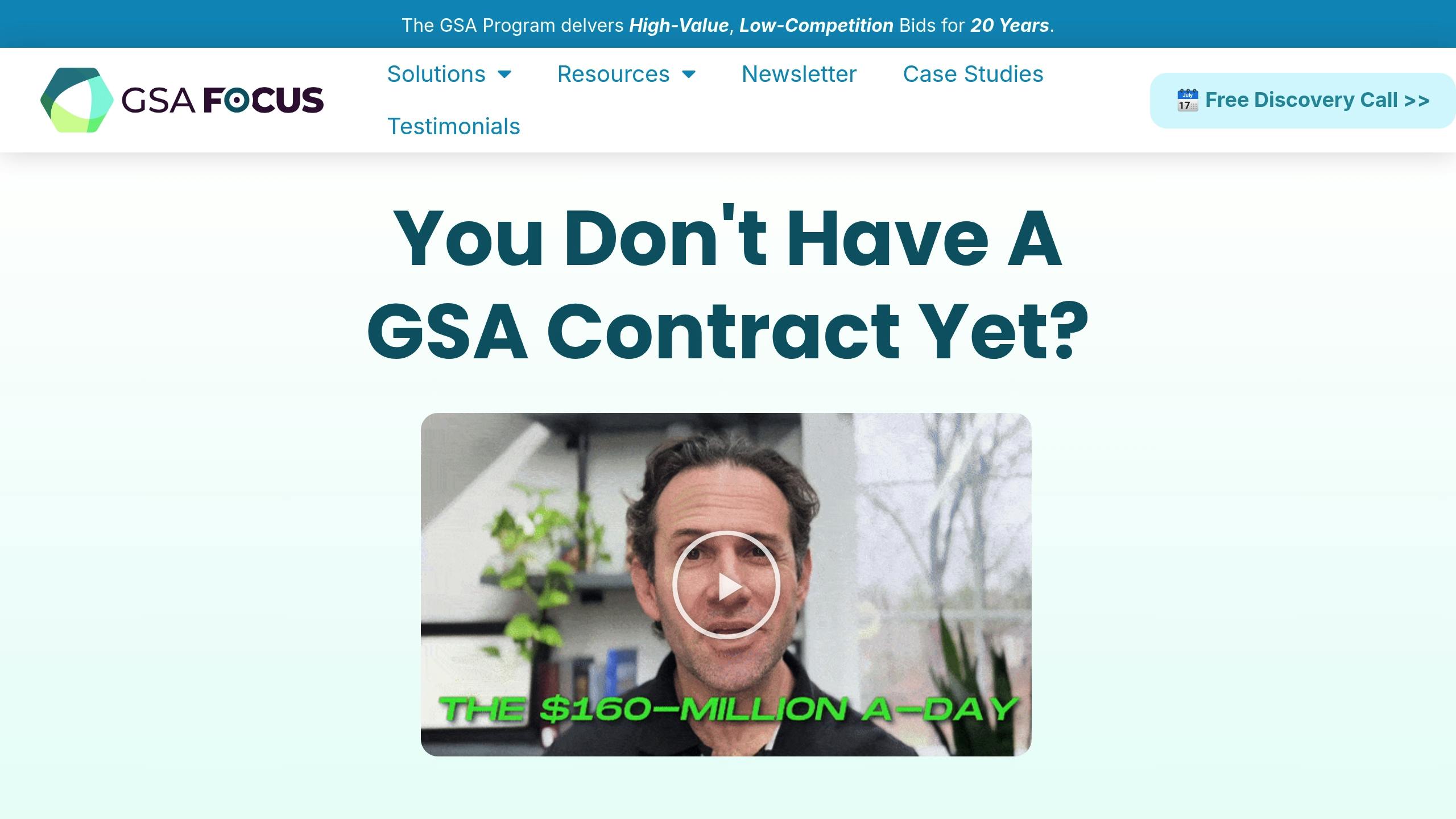Federal contracts can be a game-changer for small businesses, offering steady revenue, reliable payments, and exclusive opportunities. In FY2022, small businesses earned $162.9 billion in federal contracts. This guide explains how to build strong relationships with federal buyers by following a simple four-step process:
- Preparation: Register on SAM.gov, get certifications, research agencies, and create a compelling capability statement.
- Outreach: Connect with buyers via email, phone, LinkedIn, and federal events like industry days.
- Relationship Building: Maintain communication, track performance, and expand your network within agencies.
- Leverage GSA Schedules: Use GSA Schedules for pre-approved contracts, long-term stability, and increased visibility.
Related video from YouTube
Step 1: Getting Ready for Federal Buyers
To succeed in the federal marketplace, you need to prepare your business to meet government requirements and establish trust with federal buyers.
Meeting Federal Requirements
Staying up-to-date with registrations and certifications is critical. These elements ensure your business is eligible and credible in the eyes of federal buyers.
| Required Registration | Purpose |
|---|---|
| DUNS Number | Identifies your business |
| SAM.gov Registration | Confirms contract eligibility |
| NAICS Codes | Defines your industry classification |
| Socio-economic Certifications | Verifies special statuses |
Additionally, make sure your business has the necessary insurance coverage and is familiar with the Federal Acquisition Regulation (FAR) guidelines [3].
Finding Target Agencies
Identifying the right federal buyers starts with research. Tools like USAspending.gov and the Federal Procurement Data System (FPDS) can help you uncover valuable insights. For example, USAspending.gov shows which agencies have the largest budgets in your industry, while FPDS highlights patterns in contract awards [2].
Here’s how you can start:
- Use USAspending.gov to pinpoint agencies with significant budgets in your field.
- Review agency strategic plans to understand their goals and priorities.
Writing Your Federal Sales Pitch
Federal proposals aren’t about flashy sales tactics – they’re about demonstrating how your business aligns with the agency’s mission. Create a capability statement that includes:
- A clear connection to the agency’s goals.
- Examples of past performance.
- Relevant socio-economic certifications.
- Proof of return on investment (ROI).
Be specific. Highlight past successes and explain how you can minimize risks for the agency. If you’re pursuing a GSA Schedule, platforms like GSA Focus can simplify the process by helping with documentation and compliance.
Step 2: Connecting with Federal Buyers
Once you’ve completed your groundwork in Step 1, it’s time to focus on outreach that highlights your value to federal buyers.
Planning Your Outreach
Build a detailed database of key agency contacts, such as small business specialists, contracting officers, and program managers. Keep track of your interactions and set weekly goals for engagement. Tailor all communication to the agency’s strategic priorities identified earlier.
| Channel | Strategy & Best Practices |
|---|---|
| Keep it 2-3 paragraphs; include a clear value proposition. Best sent Tuesday through Thursday mornings. | |
| Phone | Deliver a 30-second elevator pitch. Call mid-morning or early afternoon. |
| Share relevant industry insights and engage with posts weekly. |
When reaching out, focus on addressing specific agency challenges. Federal buyers tend to work with vendors who demonstrate a clear understanding of their mission. In fact, over 80% of contracts go to vendors already familiar to the agency [4].
Attending Federal Events
Face-to-face interactions are still a key part of building trust with federal buyers. Make it a priority to attend events like agency-specific industry days, SBA matchmaking sessions, and GSA training workshops.
Pro tip: Before attending, research who will be there and prepare tailored capability statements for high-value contacts. Follow up consistently after the event, as federal sales cycles often take months of steady communication.
Using GSA Schedules
While networking, take advantage of established procurement tools like GSA Schedules. These channels account for about $39 billion of federal spending annually [1] and can help you establish credibility faster.
Federal buyers often prefer Schedule holders because of pre-negotiated terms and simplified purchasing processes. Being part of a Schedule signals reliability, which is critical for building long-term partnerships. To stay competitive, review your pricing quarterly using GSA’s market data tools. This ensures you’re aligned with market expectations and keeps your engagement strong.
sbb-itb-8737801
Step 3: Maintaining Buyer Relationships
Once you’ve made those initial connections, keeping the conversation going is the key to building long-term relationships.
Setting Communication Plans
Did you know that 80% of contracting officers say regular updates improve their perception of vendor relationships? That’s according to federal contracting data [4].
Here’s how you can design a communication strategy across multiple channels:
| Channel | Frequency | Focus | Tips |
|---|---|---|---|
| Status Updates | Monthly | Performance metrics & milestones | Keep it short and focus on key metrics |
| Strategic Reviews | Quarterly | Contract progress & planning | Use visuals like charts and graphs |
| Executive Briefings | Annually | Long-term partnership goals | Tailor reports to the agency’s needs |
Pro tip: Use a CRM to stay on top of federal interactions. Automate reminders and keep a record of every communication.
Meeting Performance Goals
Federal contracting success boils down to delivering measurable results. Make sure you’re tracking performance in a way that aligns with agency priorities:
| Performance Area | Metrics |
|---|---|
| Delivery Times | Weekly status reports |
| Quality Metrics | Monthly scorecards |
| Cost Efficiency | Quarterly analysis |
| Compliance | Continuous monitoring |
When you have clear data on your performance, it’s easier to expand your reach within the agency.
Growing Agency Networks
Contractors who network strategically within agencies are 2.5 times more likely to secure follow-on contracts [1]. Here’s how you can build on your outreach efforts from Step 2:
- Map the Agency Structure: Use organizational charts to pinpoint key decision-makers.
- Offer Cross-Department Solutions: Develop services that benefit multiple units within the agency.
- Form Strategic Partnerships: Collaborate with prime contractors to connect with new agency contacts.
Important: Always stick to agency communication protocols and ethical guidelines. And don’t forget to log every interaction in your CRM to stay organized.
Step 4: GSA Schedules for Better Results
Why GSA Schedules Matter
GSA Schedules are a powerful way to strengthen relationships with federal buyers. In fiscal year 2022, federal agencies spent $39 billion through GSA Schedules, with small businesses accounting for 37% of those sales. These schedules build on the relationship strategies from Step 3, offering a structured framework for partnerships.
| Advantage | How It Helps |
|---|---|
| Pre-Approved Status | Instantly boosts credibility and simplifies agency interactions |
| Long-term Contracts | Provides partnership stability with up to 15 years of potential |
| Enhanced Visibility | Increases exposure via GSA eLibrary and GSA Advantage! platforms |
For example, Mercom‘s Schedule contract led to repeat orders from DoD contacts and new opportunities with NASA, thanks to GSA Advantage! visibility. This resulted in $3.2 million in new business over six months – a 215% jump in federal awards.
How GSA Focus Can Help

Navigating the GSA Schedule process can be tricky, but GSA Focus offers specialized support to help small businesses succeed. Their services include:
| Service | What It Does |
|---|---|
| Document Preparation | • Saves time with expertly prepared documents |
| Compliance Assurance | • Avoids penalties with ongoing compliance checks |
| Negotiation Support | • Secures better terms with expert help |
| Marketing Strategy | • Targets the right buyers for increased engagement |
Quick tip: Use the agency research from Step 1 and performance tracking from Step 3 to make the most of GSA Focus services. Have your past performance data and financial records ready to speed up the process.
GSA Schedules lay the groundwork for lasting partnerships with federal agencies. By combining the advantages of these schedules with expert compliance and marketing support, you’ll be in a strong position to expand your federal business.
Conclusion: Next Steps
Key Relationship Steps
To build strong relationships with federal buyers, contractors often follow a four-step approach, covering everything from preparation to performance. Here’s what top contractors focus on:
| Priority Area | Key Actions |
|---|---|
| Research | Analyze agency spending, review procurement forecasts |
| Engagement | Attend industry days, connect with agencies |
| Performance | Deliver on commitments, ensure compliance |
Support from GSA Focus
GSA Focus helps simplify the GSA Schedule acquisition process by offering expert guidance. This allows businesses to concentrate on implementing the strategies outlined in Steps 2 and 3, while staying compliant with federal regulations.
Getting Started
Kick off the process with these essential actions:
- Register with SAM (a must for federal contracting)
- Use your research to target promising agencies
- Refresh and refine your capability statements
Related Blog Posts
- How to Read GSA Solicitation Documents
- How to Find Target Agencies for GSA Contracts
- How to Manage GSA Contract Performance
- Best Practices for Federal Buyer Relationships


